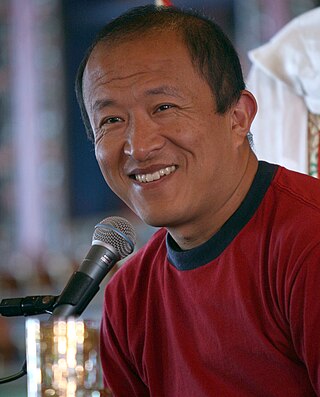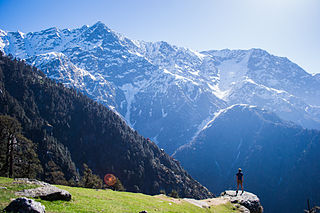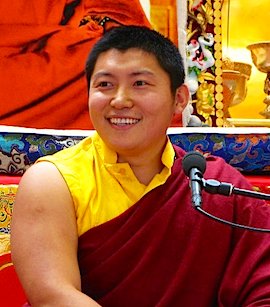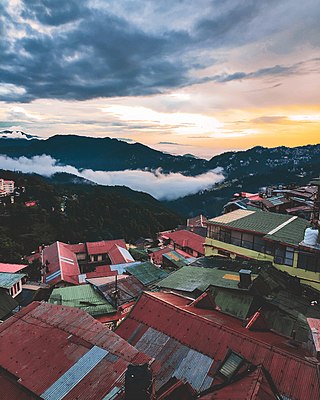A tulku is a distinctive and significant aspect of Tibetan Buddhism, embodying the concept of enlightened beings taking corporeal forms to continue the lineage of specific teachings. The term "tulku" has its origins in the Tibetan word "sprul sku", which originally referred to an emperor or ruler taking human form on Earth, signifying a divine incarnation. Over time, this term evolved within Tibetan Buddhism to denote the corporeal existence of highly accomplished Buddhist masters whose purpose is to ensure the preservation and transmission of a particular lineage.

Tashi Paljor, Dilgo Khyentse Rinpoche was a Vajrayana master, scholar, poet, teacher, and recognized by Buddhists as one of the greatest realized masters. Head of the Nyingma school of Tibetan Buddhism from 1988 to 1991, he is also considered an eminent proponent of the Rime tradition.

Jamyang Khyentse Wangpo, also known by his tertön title, Pema Ösel Dongak Lingpa, was a teacher, scholar and tertön of 19th-century Tibet. He was a leading figure in the Rimé movement.
Dzigar Kongtrul Rinpoche is the title of a tulku lineage of Tibetan Buddhist lamas. They originate with Jamgon Kongtrul Lodro Thaye, one of the most illustrious lamas of recent history, known for his central role in the rimé or non-sectarian movement in 19th Century Tibet. Jigme Namgyel is the present Dzigar Kongtrul Rinpoche. He is the second or third incarnation, depending on whether Lodro Thaye is counted.

Dzongsar Jamyang Khyentse Rinpoche, also known as Khyentse Norbu, is a Tibetan/Bhutanese lama, filmmaker, and writer. His five major films are The Cup (1999), Travellers and Magicians (2003), Vara: A Blessing (2013), Hema Hema: Sing Me a Song While I Wait (2017), and Looking for a Lady with Fangs and a Moustache (2019). He is the author of What Makes You Not a Buddhist (2007) and many other non-fiction works about Tibetan Buddhism.

Dzongsar Khyentse Chökyi Lodrö was a Tibetan lama, a master of many lineages, and a teacher of many of the major figures in 20th-century Tibetan Buddhism. Though he died in 1959 in Sikkim, and is not so well known in the West; he was a major proponent of the Rimé movement within Tibetan Buddhism, and had a profound influence on many of the Tibetan lamas teaching today.

Chagdud Tulku was a Tibetan teacher of the Nyingma school of Vajrayana Tibetan Buddhism. He was known and respected in the West for his teachings, his melodic chanting voice, his artistry as a sculptor and painter, and his skill as a physician. He acted as a spiritual guide for thousands of students worldwide. He was the sixteenth tülku of the Chagdud line.

Mindrolling Monastery, is one of the "Six Mother Monasteries" of the Nyingma school in Tibet. It was founded by Rigzin Terdak Lingpa in 1676. Tendrak Lingpa's lineage is known as the Nyo lineage. The name in Tibetan means "Place of Perfect Emancipation". It is located in Zhanang County, Shannan Prefecture, Tibet Autonomous Region, China, known as U-Tsang. Mindrolling Monastery is approximately 43 kilometers east of the Lhasa airport, on the south side of the Tsangpo river.

Kyabje Dudjom Rinpoche Jigdral Yeshe Dorje was known simply as Dudjom Rinpoche. He is considered by many Tibetan Buddhists to be from an important Tulku lineage of Terton Dudul Dorje (1615-1672), and was recognized as the incarnation of Terton Dudjom Lingpa (1835-1904), a renowned treasure revealer. He was a direct incarnation of both Padmasambhava and Dudjom Lingpa. He was a Nyingma Householder, a yogi, and a Vajrayana and Dzogchen master. According to his secretary Khenpo Tsewang Dongyal and many others, he was revered as "His Holiness" (Kyabje) and as a "Master of Masters".

McLeod Ganj or McLeodganj is a suburb of Dharamshala in Kangra district, Himachal Pradesh, India. It is known as "Little Lhasa" or "Dhasa" as the Tibetan government-in-exile is headquartered here and there is a significant population of Tibetans in the region.

Khenpo Shenga Rinpoche, also Shenpen Chökyi Nangwa (1871–1927) was a Tibetan scholar in the Nyingma and Sakya traditions of Tibetan Buddhism.
Baijnath is a town in the Kangra district of Himachal Pradesh, India. It is about 50 kilometers from district headquarters, Dharamshala. A temple of Lord Shiva (Baijnath) is situated there giving the town its name.

Bir is a rural village located in the west of Joginder Nagar Valley in the state of Himachal Pradesh in northern India. It's the paragliding capital of India and the location of the Bir Tibetan Colony, founded in the early 1960s as a settlement for Tibetan refugees after the 1959 Tibetan uprising.
Neten Chokling Rinpoche, is also referred as to the 4th Neten Chokling Rinpoche.
Orgyen Tobgyal Rinpoche, also called Tulku Ugyen Topgyal, is a Tibetan Buddhist lama who was born in Kham in Eastern Tibet in 1951, living in exile in India.

Buddhism in the Himachal Pradesh state of India of has been a long-recorded practice. The spread of Buddhism in the region has occurred intermediately throughout its history. Starting in the 3rd century BCE, Buddhism was propagated by the Maurya Empire under the reign of Ashoka. The region would remain an important center for Buddhism under the Kushan Empire and its vassals. Over the centuries the following of Buddhism has greatly fluctuated. Yet by experiencing revivals and migrations, Buddhism continued to be rooted in the region, particularly in the Lahaul, Spiti and Kinnaur valleys.

Phakchok Rinpoche is a teacher of the Nyingma lineage and chief lineage holder of the Taklung Kagyu lineage of Tibetan Buddhism. He is Vajra Master of Ka-Nying Shedrup Ling monastery, abbot of several monasteries in Nepal, and assists monasteries and practice centers in Tibet. In addition, he serves as Director of the Chokgyur Lingpa Foundation, a nonprofit organization engaged in a wide range of humanitarian projects.

Tourism in Himachal Pradesh relates to tourism in the Indian state of Himachal Pradesh. This is popularly renowned for its Himalayan landscapes and popular hill-stations. Many outdoor activities such as rock climbing, mountain biking, paragliding, ice-skating, trekking, rafting, and heli-skiing are popular tourist attractions in Himachal Pradesh.

Lobsang Dolma Khangkar also called Lobsang Dolma or Ama Lobsang Dolma was a 13th generation doctor of traditional Tibetan medicine. She travelled with the Dalai Lama in 1959 from Tibet to India. She was the First woman to become chief physician of the Men-Tsee-Khang. She and the others carried her daughters on their backs into what is now Dharamsala, India: Tsewang Dolkar Khangkar and Pasang Gyalmo Khangkar, succeeded her in the family line of doctors, the Khangkar.

Yeshi Dhonden was a Tibetan doctor of traditional Tibetan medicine, and served the 14th Dalai Lama from 1961 to 1980. In 2018, the Indian government honoured him with the Padma Shri, the fourth highest civilian award in India.


















